|
Refreshing juices of
pleasing flavor can be made from many fruits. The problem is one of so
preserving the juice that as much as possible of its fresh flavor and
appearance is retained. The most practical way of accomplishing this is
by pasteurization by heat at temperatures from 150░ to 180░ F.
26. Fruits for Juice.
Fruits for juice making should possess an agreeable flavor and aroma and
be rather tart in taste. Very sweet fruits of low acid do not make
attractive juices. Grapes should possess an agreeable flavor and high
acid. A red color is preferred to white. The Eastern varieties have
these qualities in a single variety. Two Californian varieties must be
blended; one furnishing flavor and the other color and acid. Muscat,
blended with any tart red wine grape, will give the desired result.
Concord, Isabella, or other good Eastern varieties, used alone, give
good results. The grapes should not be too sweet. A juice of 20% sugar
and .8% to 1% acid is of the proper composition.
Loganberries make an
excellent juice. They should be as ripe as possible.
Blackberries,
raspberries, and strawberries make rather poor juices.
Apple juice is used in
great quantities fresh, but a relatively small amount is pasteurized,
largely because apples may be obtained practically throughout the whole
year for the production of fresh juice.
Orange and lemon juices
have not been successes commercially, because of the difficulty in
retaining the flavor of the fresh juices.
Pomelo or grape fruit juice has been
developed commercially in Florida.
Pineapple juice as now found on the market
is attractive in appearance, but very disappointing in flavor.
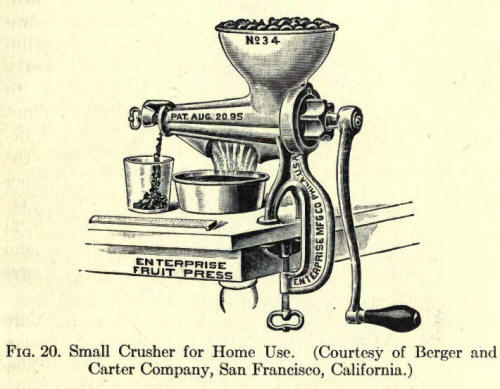
Pomegranates produce a highly colored juice
of fair flavor, but there is considerable difficulty in separating the
juice-bearing seeds from the astringent pulp.
Grape, apple, loganberry, and pomelo juices
are all easily prepared and are all of very satisfactory quality. Other
fruits may prove satisfactory sources of juice as methods of preparing
the juice are developed by investigation.
27. Crushing. To facilitate heating
of the fruit before pressing and the extraction of the juice the fruit
must be thoroughly crushed.
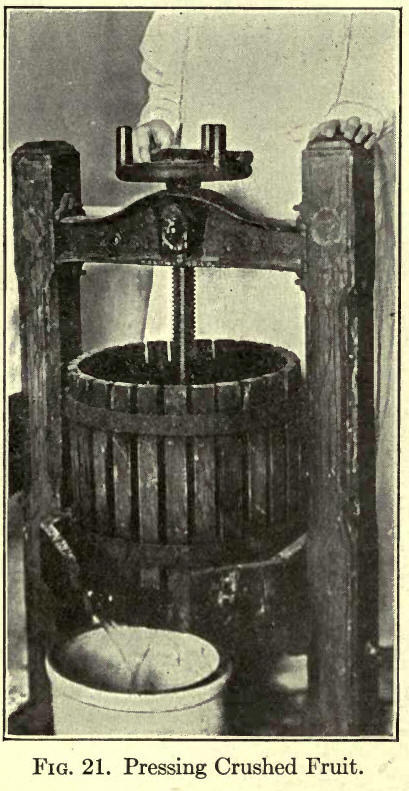
In the household a small food chopper or
small fruit crusher may be used. (See Fig. 20.) Small hand power
crushers are available for farm use. (See Fig. 22.) Larger crushers for
factory use are of many types, sizes, and prices. Grape crushers consist
of two wooden or iron cylinders revolving closely enough together to
crush the fruit but not the seeds. It is desirable to separate the
sterns from grapes after crushing. This is done by mechanical stemmers
or by hand by use of a coarse screen.
28. Heating before Pressing. The
color of grapes must be dissolved from the skins by heating. Berries
will press more satisfactorily if heated. Citrus fruits, pomegranates,
and apples should not he heated.
The crushed grapes should be heated to about
120░ to 135░ F. by use of an aluminum or agateware pot. They should be
stirred frequently and the temperature observed carefully with a dairy
or other type of thermometer, that can be conveniently immersed in the
crushed grapes. Grapes are allowed to stand twenty-four hours before
pressing to permit the color to dissolve in the juice. The grapes may
also be heated by separating the juice by pressing and heating it to,
140 to 150░ F. and returning it to the skins.
Berries should be heated to about 150 to
165░ F. and pressed hot.
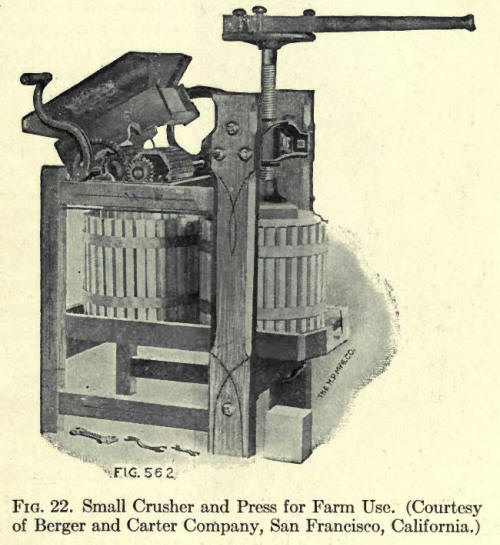
29. Pressing. The simplest press is a
heavy cloth bag which may be twisted. Small kitchen presses may be had
also. Various sizes and forms of presses suitable for farm and factory
use may be had. The hydraulic press is the most commonly used commercial
press and gives the highest pressure of any fruit press.
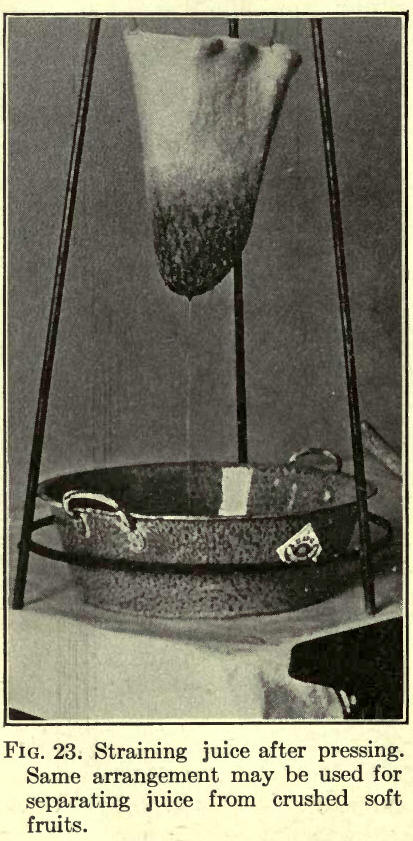
Pressure is applied directly to the fruit in
the "basket" form of press. In the rack and cloth type the fruit is held
between layers of heavy press cloths. Wooden racks separate the cloths.
This type of press gives a clearer juice than the basket press but
requires more labor.
30. Clearing the Juice. The juice
comes from the press cloudyŚnot perfectly clear. It also contains
proteins in solution which, if not removed, are coagulated during
pasteurization later and cause the juice to become cloudy. Therefore, to
produce a juice which will be clear and remain so in the bottle, it must
be heated to the temperature at which the juice is to be pasteurized
later and must then be filtered or otherwise cleared. The juice will
then clear more satisfactorily if it is allowed to stand overnight after
pressing and before clarifying. After standing this length of time it
may be drawn off from the sediment and cleared in any way desired.
The juice may be clarified by the addition
of egg white, casein, or Spanish clay before heating. These materials
are coagulated and settle out after heating, carrying down with them the
suspended particles which have caused the juice to be cloudy. Grape
juice may be clarified by any of the above materials used singly; or
with casein or egg white employed in combination with the clay. Other
juices are best clarified by the use of the clay only. Casein may be
bought from a drug store or chemical supply house. Spanish clay may be
obtained from chemical supply firms.
The casein is prepared for use by boiling
together three ounces of casein to one ounce of sal soda in one quart of
water. When dissolved, this is diluted to one gallon with water. Spanish
clay is prepared for use by soaking a weighed amount in a measured
amount of water until soft. One gallon of water is used for each pound
of clay. When soft it is worked into a thin, even-grained mud with the
water. Egg white is mixed with several times its volume of water and
stirred until dissolved. Dried albumen may also be used.
In using the clarifying materials described
above, the amount necessary is measured and added to the juice and mixed
thoroughly by stirring.
The juice is then heated to 175░ F. and
allowed to stand twenty-four hours. Most of the juice can then be poured
off clear from the sediment or filtered easily through a jelly bag.
It must be emphasized that clarification is
not necessary for the preservation of the juice, and results in some
loss of flavor. It is not generally recommended for home use. It is only
necessary in the home production of juice to heat it to 175░ F. allow it
to cool twenty-four hours, and filter through a jelly bag.
The juice may be filtered through a felt
filter bag specially made for small scale filtration or through an
ordinary cloth bag. Filter bags vary in size from one to ten gallons and
cost from one and one-half to ten dollars. Larger metal filters that are
filled with asbestos or wood fiber are used in large scale filtration,
but cost very much more.
A box filled with sand also makes a fairly
satisfactory filter. A funnel fitted with filter paper can also be used.
Filters must be thoroughly washed after use
to prevent souring. Juice is ordinarily difficult to filter, unless
clarified, and the filters must be changed and cleaned often during
continued filtration to maintain them at full capacity.
For home use a rough filtration without a
clarification is all that is required.
31. Bottling and Canning. The
previous operations have prepared the juice for the final container in
which it is to be stored. Bottles, jars, and cans are all used as
containers. These should be clean.
Two types of bottles are available: those
with plain tops to be closed with corks and those with special tops to
be closed with caps or crowns. The bottles should not be filled
completely and a space of about an inch and a half should be left
between the cork and the juice.
If the bottles are to be corked, the corks
must be sterilized in boiling water for ten minutes before they are
used. Ordinary taper corks of good quality may be used, but wine bottle
corks driven into the bottles with an inexpensive apparatus designed for
the work give better results.
The corks must be tied down with a string to
hold them in place during pasteurization.
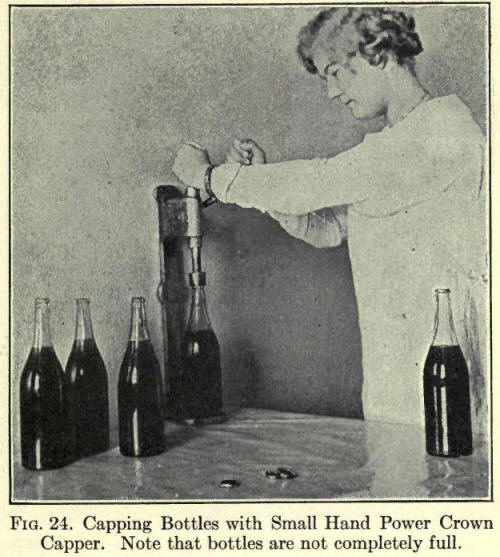
If crown finish bottles such as soda water,
beer, or grape juice bottles are used, the crowns or caps are crimped on
by a special machine. This costs from five dollars upward. The crowns
cost about thirty cents per gross and are cheaper and more attractive in
appearance than corks. If any great amount of juice is to be put up,
their use is recommended.
Cans may be used for the less acid juices,
such as grape and apple juices, but are not recommended for very acid
berry or lemon juice, because of the danger of the solution of tin in
poisonous quantities. Enamel lined cans are best and sanitary cans are
to be preferred to solder top cans because of the danger from the action
of the juice on the solder used in sealing the latter.
Cans may be filled with hot juice at 180░ F.
and sealed at once without further sterilization. A better plan is to
fill them with warm (not hot) juice, seal, and then pasteurize.
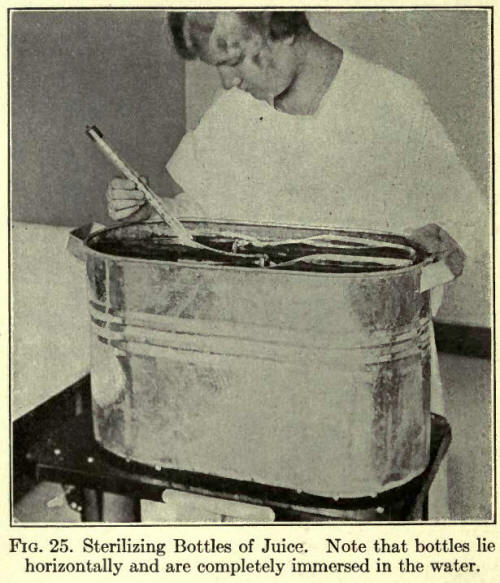
Jars may also be used. They are filled with
the warm juice and sealed at once with scalded caps and rubbers. The
juices are pasteurized in the jars.
32. Pasteurization of Fruit Juices.
Fruit juices must not be overheated but nevertheless they must be heated
to a high enough temperature to insure their keeping. This temperature
is between 165░ and 170░ F. The temperature must be maintained for about
twenty minutes. Juice should never be boiled.
The most convenient and certain way of
obtaining these conditions is to heat the bottles or cans while they are
completely immersed in water.
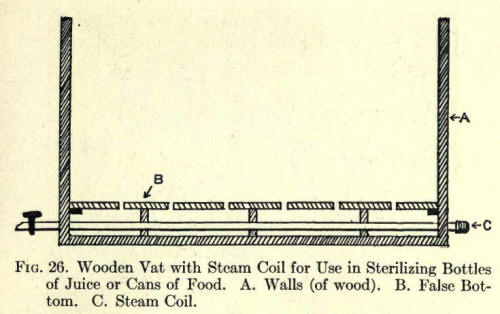
An ordinary wash boiler with a false bottom
makes a satisfactory pasteurizer; or any of the factory-made home and
farm sterilizers may be filled with water and used as pasteurizers.
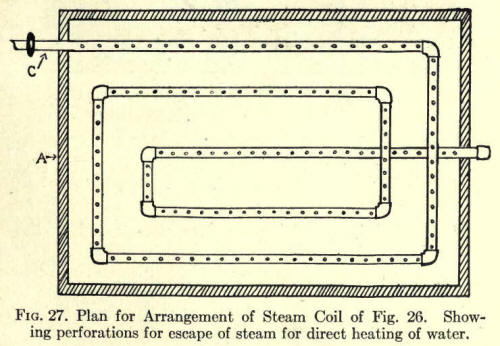
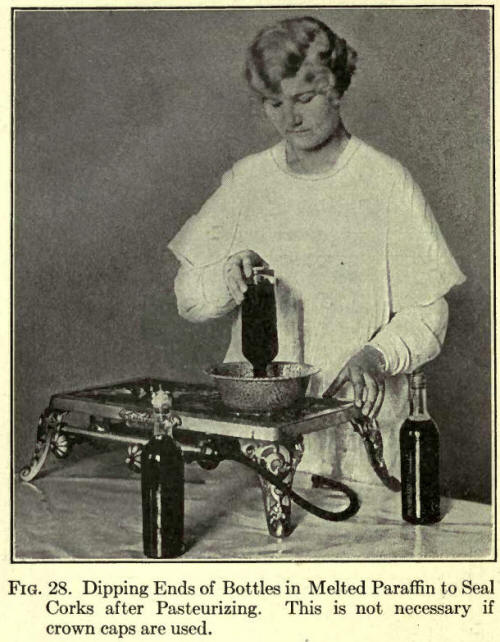
See Fig. 25. A larger pasteurizer may be
made of a wooden tank and steam coils as indicated in Figs. 26 and 27.
The sealed jars, bottles, or cans, are
placed in the pasteurizer and completely covered with water. Bottles
should lie horizontally so that the hot juice will sterilize the corks.
With a thermometer inserted in the water, it is heated to 175░ F. and
maintained at this temperature for twenty minutes. The temperature in
the containers will be several degrees below 175░ F. The bottles or cans
are then removed. The necks of corked bottles should be dipped in
paraffin or sealing wax as soon as removed and again when cool. Bottles
closed with crown caps need not be so treated. |

